In the early days of cars racing you raced with whatever could be bought and didn’t care much how it looked. Everything was about the engine and how fast you could get rolling. Aircraft were also being developed in the early part of the twentieth century and it was a natural progression to incorporate the lessons learned in streamlining aircraft into the shape of automobiles as racing speeds increased.
The first desire was to gain a competitive advantage by reducing the car’s drag or air resistance at speed. One of the first streamlined racers was the 1899 La Jamais Contente which “broke” the 100 kilometer/hour barrier. It was a cigar-shaped electric car designed to minimize aerodynamic drag.
In 1924 the Tropfenwagen (droplet shaped car) achieved a drag coefficient of Cd=0.28, which is impressive even now.
More progress was made by the German racing teams prior to WWII with their Nazi sponsored Auto Union cars that broke many speed records. What was also discovered, if not well understood, was that while these sleek shapes could cut through the air with relative ease, something else was happening – lift. These flat-bottomed bodies were producing high pressure areas under the cars. One of these record events ended tragically as the car was flipped at speed and killed the driver.
Many pointy designs were used through the 1960’s. After World War Two racers at the Bonneville Salt Flats made record breaking cars from the drop tanks from WWII fighter aircraft. Indy 500 racers were front-engined roadsters that favored rounded aluminum bodywork fastened to tube frames.
The higher the speed the more important aerodynamics becomes. If you took a one foot square plate facing it directly into the wind you would find that at 100 mph it would generate 33 pounds of drag force. At double the speed (200 mph) the drag resistance would jump to 133 pounds. At 300 mph it would generate 299 pounds of drag resistance. It takes power to overcome drag. Using this same set up we would find that at 100 mph it takes 9 hp to overcome the drag produced. At 200 mph it would consume 71 hp and at 300 mph it would jump to 239 hp. If you can keep from wasting power on overcoming drag you can go faster than your competition.
NASCAR legend Smokey Yunik raced a car that was faster than everyone else’s confounding his competitors. Eventually the secret was revealed to be that he had built a perfect 7/8 replica of the Chevy coupe. Reducing the size allowed him to reduce the frontal area and have a race car with a lower Cd (drag coefficient) than all the others, even though it looked like everyone else’s.
Smokey was a brilliant self-taught engineer. He realized intuitively that aerodynamics and hydrodynamics were very closely related so he would build model cars that he would take to the creek running in back of his garage to test how changes in the car’s shape would affect it aerodynamic efficiency.
How many of us, as children, have put our hand out of the window of a moving car and noticed how resistance changed as we rotated our flat hand from vertical to horizontal. What we discovered was that there is resistance as an object moves through the air. We also discovered that if we reduced the frontal area (moved our hand so the narrow edge faced the wind) there was less resistance, or drag, on our hand. If we kept the wide part of our hand toward the wind we might have noticed that something was happening on the back side of our hand. This was easier to see if we tried the same trick with our hand in water, maybe in the bathtub or in a pond or even a stream. What we noticed then was turbulence on the back side of our hand as the water (or air) collapsed back on itself after being disrupted and forced around our hand. This is the second of the two components of drag.
Frontal pressure and rear vacuum exist in our cars as they cut through the air. They are not as pronounced as placing a flat piece of plywood to the wind, but as speeds increase more air is pushed apart faster. Carol Shelby developed the Cobra out of an English AC roadster. It was an immediate winner at the race tracks until the straights got longer and then the reality of aerodynamic drag allowed his competition to go faster. Because of that, the Daytona coupe was developed. Those six cars had fantastic aerodynamics and badged as Cobra coupes they trounced the Ferraris at Le Mans.
In 1965 a graduate of Cal Tech, Jim Hall, applied all he had learned to a new Chaparral racing car, the Chaparral 2C. This one stunned the competition not just because its body was aerodynamically efficient, but Jim had added an articulating wing over the rear wheels.
Back in 1929 Opel designed a rocket race car that used wings to provide rudimentary down force.
Thirty-six years later Jim Hall’s Chaparral with a wing revolutionized racing. His rear wing could be moved and tilted as the car went around the track so that at high speeds it generated down force to ensure maximum tire contact and tilted it to add drag and downforce to assist in the corners. Movable aerodynamic devices were later banned by regulations.
Early open wheeled race cars mounted the wing struts directly to the unsprung suspension pieces which allowed the car’s suspensions to be much more compliant, but structural failures of the struts led to horrific crashes and such direct mounting was banned. Today’s Indy race cars mount the rear wing struts directly to the transmissions as they, like the engines, are stressed members (they form the “frame” of the car as well as being mechanical components).
You may notice that some race cars use multi-segmented rear wings. Since the angle of attack of the wing can produce drag and turbulence, breaking up the curve of a wing will allow airflow between the segments allowing for a reduction in turbulence while maximizing the down force.
Later, in 1969, Jim Hall would break ground again with what is probably the first “ground effects” race car. The Chaparral 2J used an auxiliary motor that powered a set of fans that pulled air from under the car creating a vacuum that produced huge amounts of down force and allowed the car to achieve cornering forces of up to 1.7g in turns. The underbody was sealed and the fans blew it all out the back of the car which reduced the normal turbulence created at the rear. Unfortunately any cars that could get close to the 2J were treated to a blast of road trash sucked up by the fans. This car was shortly regulated out of racing.
In the 1970’s Plymouth and dodge produced pointy ended versions of Road Runners and Chargers for the public so they could use them to dominate NASCAR. The Super Bird had a pointed front end and a high wing at the rear. They worked.
The 1978 Brabham BT46B used the same concept in Formula 1 and, after winning its first race, was promptly banned.
Lotus, in 1978, developed a fully shaped underbody to its Formula 1 car that, along with sliding side skirts, created a low pressure area under the car allowing cornering speeds to soar. The side skirts would wear and often break and the sudden loss of vacuum would result in catastrophic accidents. This technique of ground effects was also banned.
Even with all these restrictions aerodynamic engineering has allowed for Formula One car designs that achieve nearly 5g of cornering force. That is nearly what jet fighter pilots have to deal with.
Front and rear wings permeate the open wheel formula cars. The Chaparral car used what was basically a wide upside down airplane wing. Today they are narrower and use side fins to gain more efficiency. The side plates on the front wings are used to control the air flow hitting the front of the open tires since the wide tires and wheels are the source of a great deal of aerodynamic inefficiency. In fact, wheels can contribute up to 50% of the drag of a streamlined car. You may also notice the front wings will have segments near the side plates that are deeper yet in the middle of the wing the cord is shallow. That is to allow air to be guided under the car and toward the radiator intakes efficiently with as little disruption as possible.
At one point Formula 1 car designers realized that flexibility could be designed in to the construction of the wings so that at higher speeds they would flex into a flatter shaped wing with less drag and then spring back into a shape that produced meaningful downforce for the corners. These have been regulated out of designs.
Back in around 1978 the inverted airplane wings used needed some reinforcement at the trailing edge and the Gurney flap or wicker bill was born. Contrary to aerodynamic logic this flap resulted in less drag and higher track speeds at Indy. Fortunately, this aerodynamic addition was not banned and is now used in many forms of racing.
Ground effects or generating downforce with a vehicle’s body design has become the norm in racing. Even in the NASCAR cars you can see the pronounced rake to the body as well as the huge rise behind the rear tires. All of this is to produce a low pressure area under the car and keep the tires pressed against the track for maximum cornering.
In 1979 Jim Hall produced a winning Indy race car using ground effects designed into the underbody of the car.
Today’s racing cars have to incorporate aerodynamics into all aspects of their cars. It is more than just a matter of slapping on some wings in the front and the rear. Like all things automotive each part of the race car’s aerodynamic system has to work in concert as a change in the front wing might result in the need to redirect air going to the underside of the car as well as the cooling inlets and then a further change in the rear wing as the airflow changes.
Often the type of track will dramatically alter the downforce requirements of a race car. A 1992 Indy race car would develop 3460 pounds of downforce and 1310 pounds of drag at 165 mph on a short oval while on the Indy speedway the downforce produced would drop to 2835 pounds and drag would be reduced to 972 pounds attaining this at 220 mph. With that much downforce these cars can run on an upside down race track.
An Indy tech told me that the difference between a competitive Indy driver and a great Indy driver was the amount of downforce that was required to get the car to handle. The better driver could live with less downforce and drive their way through the handling demands.
So what does all this have to do with your street car and its fashionable spoiler tacked to the trunk? Aerodynamics still has a role in street cars and you don’t have to be going at 200 mph for it to concern you. The frontal area will produce drag, the air collecting under the car will produce lift, the shape of the rear facing parts will create turbulence and additional drag as well.
So what can you do about it? Street cars are designed for utility as well as looks. People look at cars primarily as a statement of how they wish to be perceived. They will rationalize sacrifices in fuel economy or carrying capacity for the sake of image or a desire for a certain level of performance.
During the 1980’s the Pontiac Firebird and the Chevrolet Camaro often competed for which car could produce the lowest Cd or drag coefficient. The bodies were very similar with the only real difference being the changes in the front and rear bumper cover, but the Firebird always seemed to squeak by with a slightly lower Cd. The numbers were derived from wind tunnel testing at the same facility. Later it was revealed that the Pontiac team would remove the rear view mirrors from the doors to get their number.
If you want to get the most out of your car’s aerodynamics you can keep it clean and waxed. Then you can change out the springs to produce a more raked body where the front end is closer to the ground than the rear. That will help to produce a low pressure area under the car. You can further enhance this by installing an air dam on the front keeping it as close to the ground as you find practical. Then you can clean up the underside of the car by covering or removing items that produce turbulence. Don’t forget to allow air flow to facilitate cooling of the engine compartment. A spoiler in the rear will provide additional downforce or you can opt for a wing to get less drag and more downforce by putting it up in cleaner air. Those wide tires you added will produce better traction, but may cost you a 30-35% penalty in drag, so see if you can make the wheel wells smaller.
Or you can buy a Ferrari where the factory does all the design and testing for you. The Ferrari 360 Modena uses venturi tunnels to maximize downforce to the point that it dispensed with spoilers. It only took 5400 hours of wind tunnel time and goodness knows how much analysis.
Yes, you probably won’t get much benefit in a performance sense unless you are close to or exceeding 100 mph, but air management can help with crosswinds at low speeds as well.
You and I can’t afford time in a wind tunnel, but we can get some idea by watching where road dirt accumulates on the car body (drag turbulence) and when we wash our cars we can spray water and watch how it flows across the body panels. Then we can save our pennies for a Ferrari.

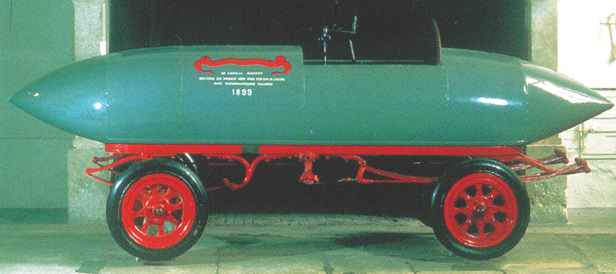
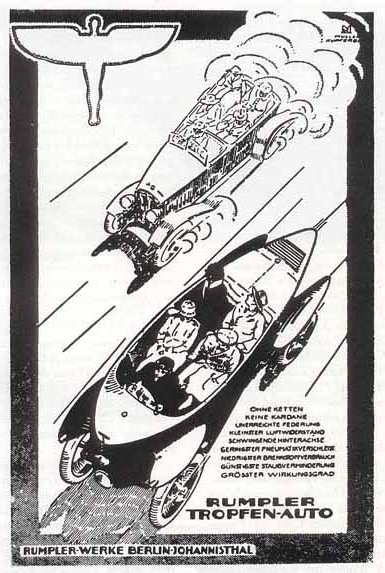
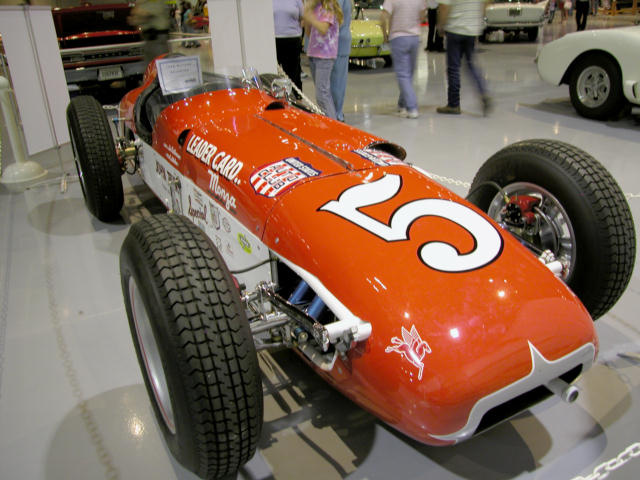
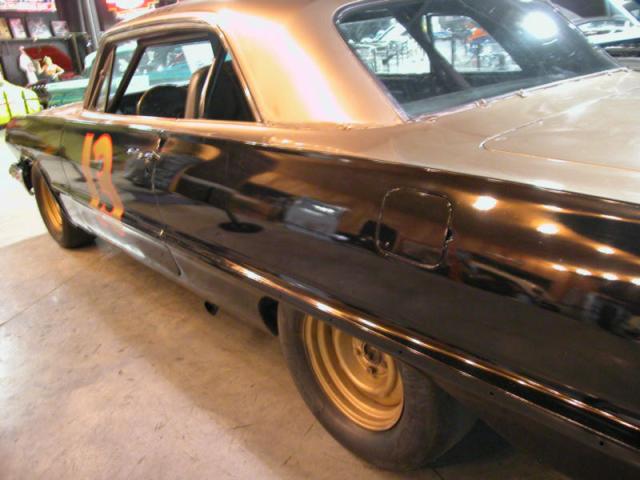

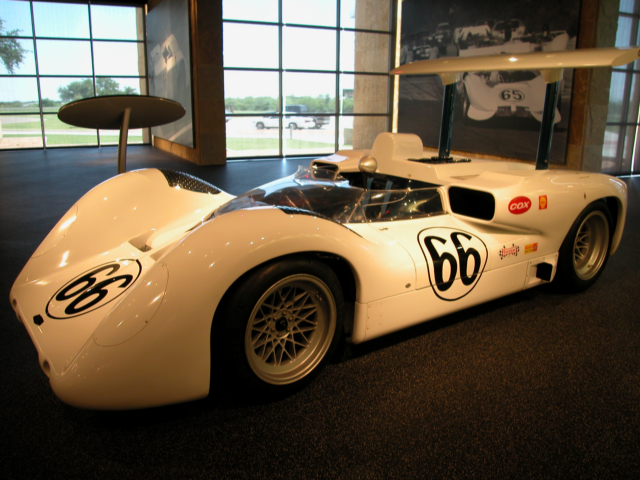
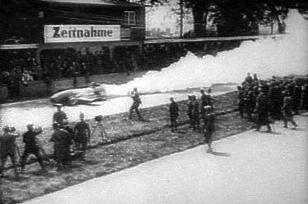
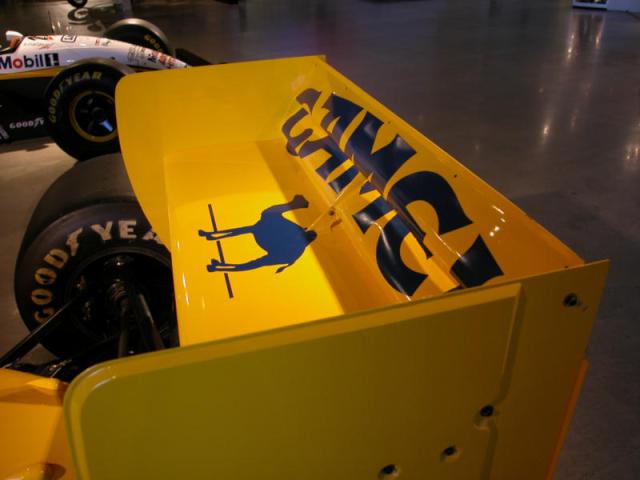
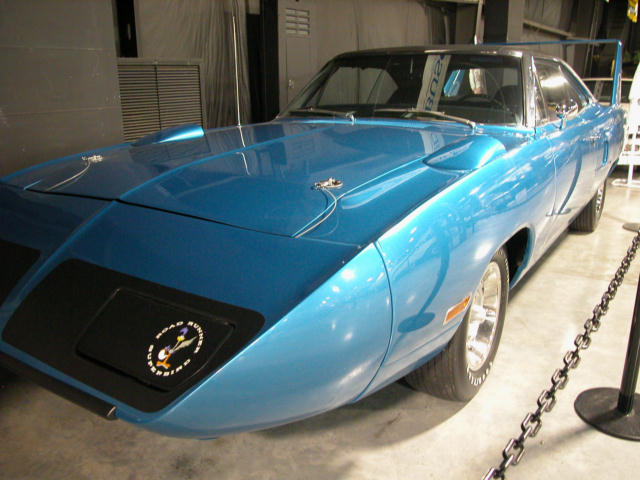
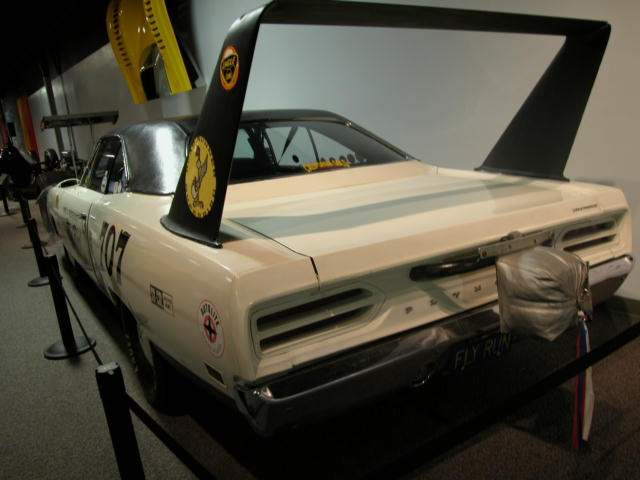
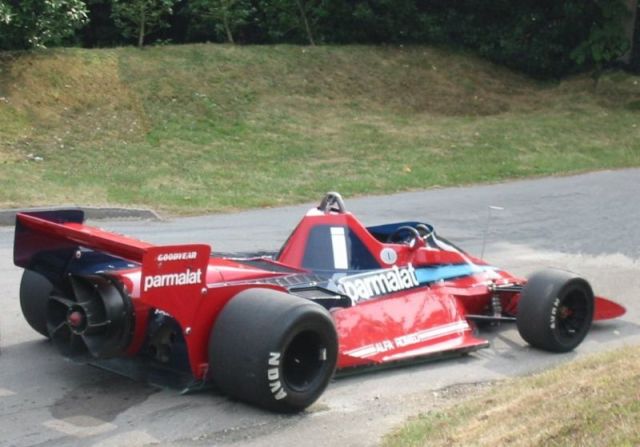
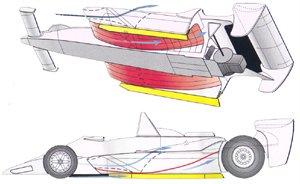
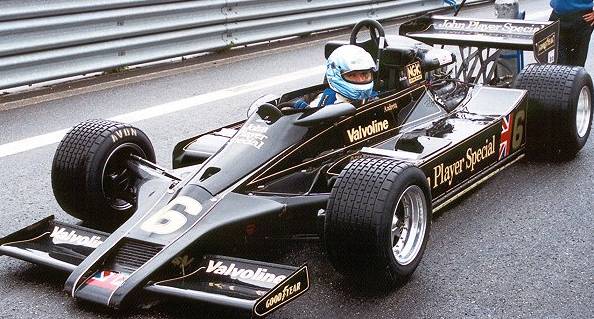
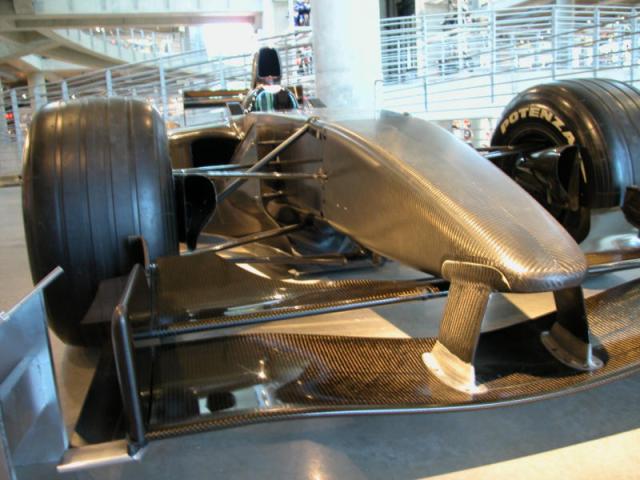
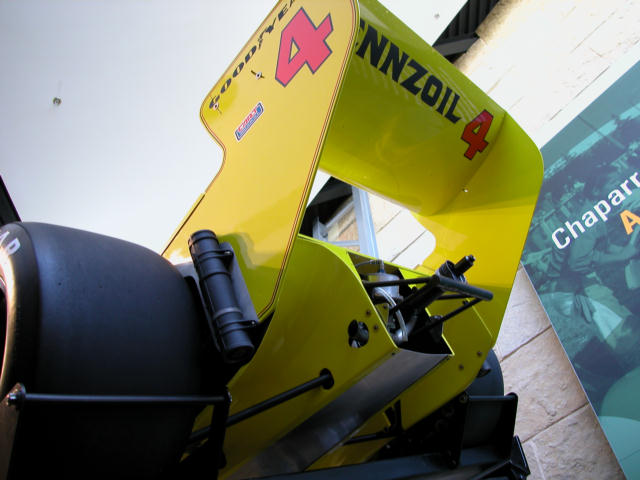

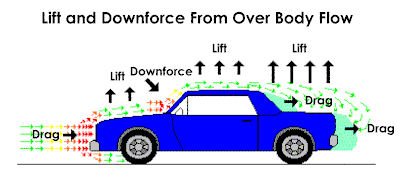
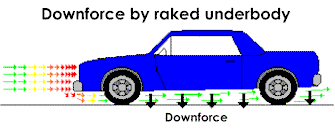
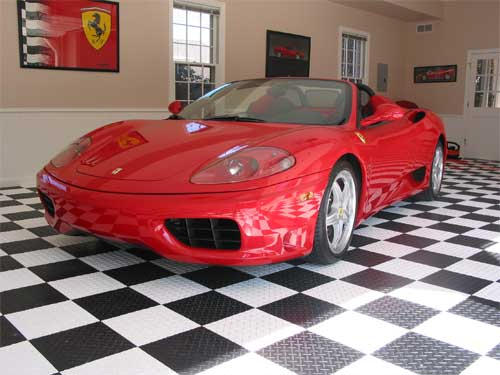
This is one outstanding article, Jim.
You really did some great research and brought out some cool stuff I sure didn’t know, and I love this stuff. Boy, the Chapparals sure bring back some memories. There was something else around then…. the UOP Shadow?? Also used vacuums, I think. It was banned, too. Isn’t it just great when being smarter than other people is a bad thing?
The flexible wings that were banned come from airplanes and you can see them on some of the big airliners, the Boeing’s 767 and 777. Also the Airbus 330 and 340. The wings look flat on the runway, but as lift comes into play they develop a lovely upward bend on the outer half of the wing that makes them look quite elegant.
As for drag.. I need to reduce in on my Saab 9000 because the rear end is flat and vertical and gets filthy. It gets covered with snow when I drive in a blizzard–an d that’s at low speeds–30 -40.
Maybe I do need a wing….
Cheers for a superb piece!
Ahh yes, the UOP Shadow. The first version had tiny wheels so they could keep the profile and frontal area to a minimum. I found this link to some photos of the second car: http://www.photoessayist.com/canam/uop/
The Shadow team built the first race car using titanium. It was the Ti22 and I believe David Hobbs drove it some.
It is interesting to note that modern wind tunnels consist not only of moving air, but moving roads underneath the cars. There are multiple dynamics going on with the airflow across the moving road as well as the tires as they turn.
Jim,
Great post – thanks for taking up the teaser I suggested a couple posts back. You really outdid yourself, especially with some of the more subtle points like observing dirt deposits. I’ll bet that actually drag forces can and do fluctuate as the air being pushed ahead of the car interacts with the road surface and other vehicles – hence drafting.
Very interesting read Jim – well thought out and articulated.
Related to rake: where would you say the balance between center of gravity & downforce occur in “lower” speed turns? Say you’re running a road course – would it be better to have the whole car slammed or have the rear a bit higher for some rake, assuming a well tuned suspension of course? Obviously more goes into it than just that, but for discussion’s sake…
Curious as I will some day probably put OEM height or even 5/16″ raise springs in the Goat instead of the 1/2″-ers in there. I will probably need some more height to fit 275 tires…
Road course handling makes thing quite complex as you can imagine. It changes if the road course is basically flat or not, too. Most road courses have high speed straight sections where raking the body would provide the benefit of reducing lift under the body. With road courses you also have to concern yourself with diving while braking and the weight transfer that occurs, the body roll in the turns and the resulting weight transfer, along with the roll center change as the front end is lowered, and finally the roll axis of a car that has rake front to rear.
All good points. Thinking to the GTO, say a 1″ drop in the front & 5/16″ raise in the rear (which are stiffer than the 0 drop springs), I’d imagine the roll center would be moved forward in the car. With the weight of the engine playing in with the more forward roll center, it seems like the raised rear end & stiffer rear springs would make the rear end more prone to sliding out. Perhaps that could be made more neutral with an adjustable sway bar.
Pingback: going lower. . .inserts. . . - PriusChat Forums
With the amount of downforce the Formula 1 cars create, is it possable that if the car was traveling @ top speed on a straightaway, for sake of argument, and the track were to invert, would the car remain on the roadway?
With the amount of downforce currently achieved by Formula 1 cars it is true. This is true even for American Indy style cars. This capability is achieved well before top speed in most cases.
Hiya Jim,
I am a Mechanical Engineering student and currently conducting a thesis on underbody aerodynamics. I found this article very stimulating and would like to thank you for your time and effort. I am particularly interested in the image you have of the 1924 Tropfenwagen. I wish to use this image in the introductory section of my thesis but have been unsucessfull in finding sufficient information to properly reference it. I was wondering if possible, do you know the origin of this image, if so it would be very helpful.
Pingback: Random Wind Tunnel and Smoke Pictures Thread - Page 9 - Fuel Economy, Hypermiling, EcoModding News and Forum - EcoModder.com